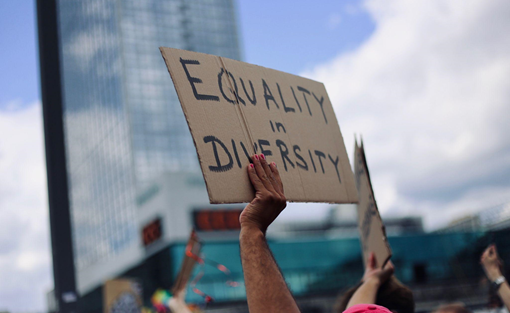Breaking the Bias in the Workplace & Beyond
Whether you’d like to admit it or not, we’ve all been a little biased at times. While some biases are harmless, certain biases are ingrained into our society and have hurt groups of marginalised people over the years. This year, the theme for International Women’s Day 2022 was ‘Break the Bias’ and while the starting point of the conversation is around women, biases are not just limited to gender. Instead, we should begin thinking about biases across the board in all aspects of our lives and even in the workplace.
As business journalist and editor, Cathryn Newbery, said “Influences such as our background, experiences and environmental conditions can all play a part in shaping our choices, whether we realise it or not. For the most part, this is not a major issue. But we display unconscious bias when we favour or discriminate against people because of these influences without even realising it.”
As a society, we’ve been fed certain biases throughout our lives by the systemic powers around us, which have led to discrimination against certain groups. As we continue to internalise these biases, we may behave in a certain way or make uninformed decisions that could potentially hurt others. Breaking biases is a step forward to creating an equitable world and requires a lot of learning and unlearning.
What is Bias?
Biases creep into our minds in various ways whether it’s through our environment or experiences. There are times when we are conscious of our biases but sometimes we fall into biases unknowingly. Certain biases have negative implications in the workplace, which could affect the psychological safety of your team in the long run. As part of your professional development as a leader, it’s important to understand and recognise the biases you may have and address them.
Conscious Bias
Conscious bias refers to the biased attitudes that we are fully aware of and act upon knowingly. These conscious biases can be intentionally malicious as we purposely discriminate against others. These biases can usually be recognised and observed easily from behaviour.
Unconscious Bias
Unconscious biases are biased attitudes that occur outside our awareness. Most of the time, we never really realise we have these biases that can even contrast our beliefs and values. They are a lot harder to detect and we may never realise the impact it has when we make decisions.
Why we need to break the bias in the workplace
Both conscious and unconscious biases have repercussions on organisations and the well-being of employees. They even impact organisations economically. Studies have shown that companies lose more than $64 billion dollars as a result of workplace bias.
As leaders, it is extremely essential to keep this bias in check as it can result in poor decision-making at the time of hiring, or upskilling employees. Our biases also can affect our team’s motivation and trust in you as their leader.
In our recent virtual panel, Breakthebias: The Road to Resilience, we discussed the importance of removing biases in our daily lives. Here are some insightful takeaways:
Helps us make better decisions
Leaders have to make important decisions and biases could hinder your decision-making process as you may not fully rationalise the situation. Most of the time, we make decisions based on our past programming of what we’re familiar with. Unfamiliarity scares us but could potentially lead us to make the wrong decisions. Unfamiliar situations are always bound to happen and sometimes they can be a blessing in disguise. Making decisions based on familiar biases affects our learning and development as we sabotage ourselves from growth and personal excellence.
In order to make better decisions away from biases, it’s best to separate the decisions from emotions so you can make objective judgments. These emotions could be in the form of preferences, fear or anxiety, which can take away our ability to think in a state of calmness and objectivity.
Increased success through diversity and inclusion
Breaking biases can cultivate diversity and inclusion in the workplace, improving relationships in a team. When a leader breaks their biases, it allows each one of their team members a chance to reach their optimal performance. Disallowing discrimination among employees on the basis of gender, race, and culture gives everyone equal opportunities to thrive and share their skill sets. Members will feel like they matter and have a part to play in the workplace, increasing their sense of value as well as using their diverse skills to create high performing teams
However, it’s important to incorporate inclusivity sincerely and not just because the term is a buzzword in 2022. For example, some companies are pushing women into leadership roles for the sake of filling a diversity quota. This may actually backfire as it can make employees feel like a corporate tool instead of recognising their talents. Instead, leaders should look out for a gap in skills stemming from the lack of diversity, and champion professional development over social identities.
“Strength lies in differences, not in similarities.”
~ Stephen Covey
How can we break the bias in the workplace?
In our insightful and perceptive discussion on The One with the #Breakthebias DNA episode, we identified a few ways leaders can break the bias in the workplace and build a safe work environment for their team.
Acknowledging barriers
It can be problematic to view individuals on the same playing field with equal opportunities because this is completely false. It’s important to recognise that certain groups of people face barriers in their daily lives due to systemised standards. For example, women have to go on maternity leave for recuperation but this leaves them with a gap in experiences from their months away from work. This could put them at a disadvantage compared to their male counterparts.
As leaders, you have to build emotional intelligence and empathise with the issues others face and find solutions for them. Viewing the impact of these barriers as negative leads to biases but showing empathy can break them. Leaders should also impart this knowledge of acknowledging barriers to their team to create an all-rounded empathetic and safe work environment.
Listening attentively
We usually perceive conflicts in the workplace as dysfunctional but it can be turned around by improving listening skills to understand all parties involved. Unfortunately, a lot of us have a habit of not fully listening to others as we’re already forming our own opinions and biases in our heads before hearing everyone’s side. If you actually attentively listen without the distractions in your head, you might find that the conflicts can be turned into successful solutions.
Listening also means stopping yourself from forcing your perspectives on others. Even if you disagree with another party, understanding their side objectively is a step forward to appreciating different opinions. Understanding can make all the difference when it comes to handling conflicts and breaking the bias.
Developing the Unbiased Habit
Stamping out biases always starts with the individual. As we said, breaking the bias is all about learning and unlearning and this takes self-awareness to pin-point your past faults and start anew. Here are some tips you can follow to develop an unbiased habit and break free from making assumptions about others.
Find differences, not similarities
As humans, we tend to steer toward things we are familiar with or find commonality in people However, this stops us from growing and instead creates a tunnel vision of the world around us. Interacting with those who are different from you will make you more aware of how their differences affect their everyday circumstances compared to your situation. Being empathetic to differences can break biases.
Heightening Awareness
Increasing self-awareness is crucial to practising rational and unbiased habits. Start with analysing your behaviour towards others. Notice your reactions, responses and judgements in different conditions. Ask yourself if your reactions are objective or are there underlying biases. Increasing awareness is a journey that requires constant attention to your interactions and thoughts so go easy on yourself!
Take care of yourself
Stress and anxiety can impact us mentally and emotionally and when we’re not taking care of our well-being, our biases tend to bubble to the surface. Negative emotions can muddle our minds to stop us from thinking objectively and instead, continue the cycle of biased patterns. Take a breather and unwind by taking breaks or talking to a friend to clear your head.
As biases have been fed to us through our social systems and environments, it has been ingrained in us for a very long time and it’ll take more time for us to unlearn them through self-awareness. As leaders, we’re in charge of the workplace so it’s our duty to instil unbiased opinions and impart empathy in these social environments. As long as we’re consciously working towards breaking the bias step by step, we can hope for an equal world.
References:
1. Breakthebias: The Road to Resilience– https://youtu.be/7Px_Edrnw4U
2. Breakthebias: Grounded or Stuck– https://youtu.be/KKexxNJ9XWA
3. The One with the #Breakthebias DNA– https://youtu.be/hXushs3aeu8
4. Finding Balance– https://youtu.be/6HRl3TctwgY
5. https://www.peoplematters.in/article/diversity/diversity-and-inclusion-how-can-organisations-construct-an-equitable-playing-field-33415
6. Photo by Amy Elting on Unsplash



